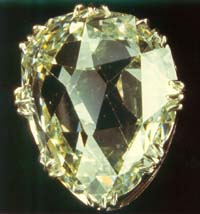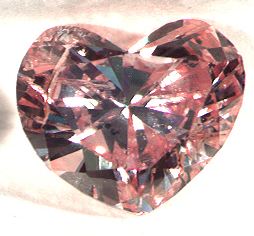The Sancy Diamond

Beautiful Sancy Diamond
The Sancy Diamond has one of the most interesting, colorful, confused and involved histories of all the famous diamonds in Europe. It is a pale yellow 55.23-carat shield-shaped stone, apparently of Indian origin, and is said to be one of the first large diamonds to be cut with symmetrical facets. The stone is also unusual because it has no pavilion - just a pair of crowns, one on the other.
In 1570, the stone was purchased in Constantinople by the French Ambassador to Turkey, Nicholas Harlai, the Seigneur the Sancy, who was an avid collector of gems and jewelry. This passion for personal adornment was more in evidence during the 1500's and 1600's in Europe than any other time and any other place, except in the East. He brought it to France, where Henry III, who was very sensitive about being bald, borrowed it to decorate a small cap he always wore to conceal his baldness. Sancy was a prominent figure in the French Court at the time. Henry was the vicious, vain, weak son of Catherine de Medici.
During the next reign, when Sancy was made Superintendent of Finance, Henry IV borrowed the gem as security for substantial loan to hire soldiers. A messenger was dispatched with the jewel but never reached his destination; thieves had followed him. Knowing that the man was loyal, Sancy made a search of him and his body was discovered, disinterred, and in the stomach of the servant the diamond was found!

Great Sancy Diamond
Sancy sold the diamond to James I, and in 1605 Inventory of Jewels in the Tower of London, the jewel in described in the unusual language of the period: "...and one fayre diamond, cut in fawcetts, bought of Sauncy."
It remained in England until 1669. Charles I, son of James I, was beheaded and his widow, Henrietta Maria, presented the jewel to Somerset, the Earl of Worcester, from whom it passed once again to the English Crown. James II later owned it, but he lost it in the disastrous battle of the Boyne and fled to France. Although Louis XIV was a pleasant and generous host to James, shabby, mournful, exiled kings bored him. James, in desperation, sold the stone to the greedy king, who was known for his love of diamonds. Louis gave him $25,000, which did much to impress James with the security value of gems in time of need.
According to another gem historian, the Sancy was sold under different circumstances. During the Civil War, Queen Henrietta Maria took it to the Continent and pledged it, together with other diamonds, to Duke of Epernon for 460,000 livers. In 1657, Cardinal Mazarin paid off the Duke and, with the Queen's consent, took possession of the gems and bequeathed them with other fine stones to Louis XIV.
In 1792, at the beginning of the French Revolution, the Sancy and other famous gems were stolen from the Gerda Meuble (Royal Treasury) in Paris. It reappeared in 1828 and was sold by a French merchant to Prince Anatole Demitasse of Russia; the prince, in turn, is recorded as selling it in 1865 for $100,000. Two years later, it was displayed by the French jeweler, G. Bapst, at the Paris Exposition, bearing a price tag of FR 1,000,000 (one million francs).
In 1906, the sancy was purchased by William Waldorf Astor as a wedding present when his son (later 2nd Viscount Astor) married Nancy Longhorn of Virginia. Lady Astor often wore the big shield-shaped gem in a tiara on state occasions. In 1962, it was one of the features of the Ten Centuries of French Jewelry exhibition at the Louvre Museum. After Lady As tor's death in 1964, the celebrated stone was inherited by her son, the 3rd Viscount Astor. The gem is set in a mounting that permits it to be affixed to the head ornament.

The Maharajah of Natalie also claimed ownership of a 'Sancy Diamond.' Although this stone is similar in shape, it weighs 60.40 carats, or about ten percent more more than the Sancy of the Astor Family. The Sancy now resides in the Louvre Museum, Paris.
Michael Hing, a jeweler from Great Britain whom I've corresponded with a number of times, has handled the Sancy Diamond, and writes, "It is currently set in a sort of bezel, like a plain border of white gold around the girdle. No prongs, and a visible gap. It is on a pin. It's almost colorless, but there is a very faint pale greenish-yellow tint to it. The color is far less noticeable than the photo, you'd think it was colorless unless you knew what to look for. Mind you, I didn't examine it under ideal circumstances: a dark blue vault under the yellowish light of an almost worn-out penlight, with about fifteen French museum people trying to tell me not to touch the stone because only people with the rank of 'Head Curator' or above were allowed to handle it."
the Sancy, a pale yellow diamond of 55.23 carats (11.05 g), was once reputed to have belonged to the Great Moguls of antiquity, but is more likely of Indian origin owing to its cut which is unusual by Western standards.
The shield-shaped stone comprises two back-to-back crowns (the typical upper half of a stone) but lacks any semblance to a pavilion (the lower portion of a stone, below the girdle or midsection).
The Sancy's known history began circa 1570 in Constantinople when purchased by Nicholas Harlai, Seigneur the Sancy. He was popular in the French Court and was later French Ambassador to Turkey. Something of a gem connoisseur, the Sancy used his knowledge to prosperous advantage.
Henry III of France suffered from premature baldness and tried to conceal this fact by wearing a cap. As diamonds were becoming increasingly fashionable at the time, Henry arranged to borrow the Sancy's diamond to decorate his cap. Henry IV also borrowed the stone, for the more practical purpose of using it as security for financing an army. Legend has it that a messenger carrying the jewel never reached his destination, but the Sancy (by then Superintendent of Finance) was convinced that the man was loyal and had a search conducted until the site of his robbery and murder was found. When the body was disinterred and autopsied, the jewel was found in the faithful man's stomach.
the Sancy later sold the diamond to James I (successor of Queen Elizabeth) about 1605 when it is thought the Sancy acquired its name. It was described in the Tower of London's 1605 Inventory of Jewels as "...one fayre diamond, cut in fawcetts, bought of Sauncy."
The Sancy remained in England until 1669 when it was briefly possessed by the unfortunate Charles I (King of England, Scotland and Ireland) and then by his third son James II. Beleaguered after a devastating defeat, James took shelter under Louis XIV of France, a fickle host who tired of his exiled guest. Facing destitution, James had no choice but to sell the Sancy to Cardinal Mazarin for the reported sum of £25,000. The cardinal bequeathed the diamond to the king.
The Sancy's history is unknown from then until 1828 when purchased by Prince Demidoff for £80,000. It remained in the Demigod family collection until 1865 when sold to Sir Jamsetjee Jeejeebhoy, an Indian prince, for £100,000. He sold it only a year later, creating another gap in its history. It reappeared in 1867, displayed at the Paris Exposition, carrying a price tag of one million francs; the gem then vanished again for forty years